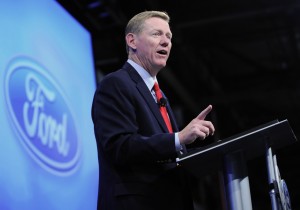Ford Motor Co. CEO Alan Mulally has reason to celebrate after achieving one of the top goals he set after joining the Detroit automaker more than five years ago; Fitch Ratings boosting the maker’s debt to investment grade status.
Though several other key ratings agencies have yet to weigh in, the move by Fitch signals growing confidence that Ford’s turnaround is sustainable – and helps the maker maintain momentum by, among other things, reducing its debt costs. It is also expected to boost Ford’s standing in the stock market, the upgrade quickly triggering a sharp jump in Ford’s share price.
“We are very pleased with today’s decision by Fitch,” said Bob Shanks, Ford’s Chief Financial Officer. “It is an important proof point of the continued progress the Ford team is making with our One Ford plan. Moving forward, we will continue to focus on driving profitable growth for all of our stakeholders. In fact, our One Ford plan includes achieving strong investment grade ratings and maintaining investment grade throughout an economic cycle.”
Ford has seen its credit rating improve significantly over the last several years, but the Fitch upgrade moves it to triple-B-minus, a one-step upgrade and the first level in the so-called investment grade category.
Ford’s outlook is “stable,” and in announcing its decision, Fitch said the maker has achieved sufficient free cash flow and liquidity, while improving its cost structure enough to maintain the solid performance of recent quarters. The maker, it said, is “in a solid position to withstand the significant cyclical and secular pressures faced by the global auto industry.”
CEO Mulally has made the investment grade rating one of his most cherished goals and came tantalizingly close last year when several agencies nudge its debt up to the debt tier of junk status after Ford reinstated its stock dividend.
Ford’s U.S. sales rose 5% during the first quarter of this year, and though the maker has yet to release January to March earnings results, it reported a 2011 operating profit of $8.8 billion, up $463 million from the year earlier.
Nonetheless, there were some issues that concerned industry analysts, including a slowdown in the fourth quarter of 2011 that notably reflected problems abroad – both in Europe and in the Asia/Pacific region. Ford has been a late arrival in the key Chinese market but this month announced plans to add a new plant, boost production at existing operations and double overall output to 1.2 million vehicles annually by mid-decade.
Fitch did note there are a few other concerns as it nonetheless approved the Ford upgrade. It pointed to the uncertain global economic recovery, especially in light of the continuing crisis in Europe.
But Fitch concluded, “The company has a lower break-even volume as a result of its restructuring actions over the past several years,” adding that, “Ford’s more balanced product portfolio has put it in a better position to weather the likely mix shifts to smaller vehicles typically seen in economic downturns.”

